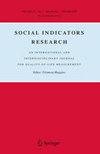生活质量、幸福和人类发展指数:发达国家的媒体叙事?
IF 2.8
2区 社会学
Q1 SOCIAL SCIENCES, INTERDISCIPLINARY
引用次数: 0
摘要
人类发展指数(HDI)是联合国开发计划署(UNDP)自1990年开始编制的。联合国开发计划署在其年度《人类发展报告》(hdr)中提供了基于人类发展指数的各国排名,其理念是,当各国将其在排名中的表现与他们认为的同类国家进行比较时,这些排名将有助于带来积极的变化。hdr在媒体上被广泛报道,以前的研究表明,报纸对HDI的报道程度(即文章数量)对排名靠后和靠前的国家更大。然而,在这些媒体如何报道人类发展指数的知识方面存在差距。例如,报纸对人类发展指数的报道在多大程度上将其等同于“生活质量”和“幸福”等术语,这与基于人类发展指数的国家排名有何关系?这就是本文所报道的研究所要解决的问题。结果表明,报纸确实经常将“生活质量”和“幸福”这两个词与人类发展指数联系在一起,而且与排名垫底的国家相比,排名靠前的国家(即那些拥有更多“人类发展”的国家)的联系似乎更强。这表明,人类发展指数报告与“生活质量”和“幸福”之间的联系是媒体认为适合发达国家而不是发展中国家的一种叙述。本文章由计算机程序翻译,如有差异,请以英文原文为准。
Quality of Life, Well-Being and the Human Development Index: A Media Narrative for the Developed World?
Abstract The Human Development Index (HDI) produced by the United Nations Development Programme (UNDP) has been in existence since 1990. In its annual Human Development Reports (HDRs) the UNDP provides rankings of countries based on the HDI, and the idea is that these will help bring about positive change as countries compare their performance in the rankings with what they see as their peers. The HDRs are widely reported in the media, and previous research has suggested that the extent of newspaper reporting of the HDI (i.e. number of articles) is greater for those countries at the bottom and top end of the rankings. However, there are gaps in knowledge about how the HDI is reported in these media outlets. For example, to what extent does newspaper reporting of the HDI equate it to terms such as ‘quality of life’ and ‘well-being’, and how does this relate to the ranking of countries based on the HDI? This is the question addressed by the research reported in this paper. Results suggest that newspaper do often associate the terms ‘quality of life and ‘well-being’ with the HDI, and that the association appears to be stronger for countries towards the top-end of the rankings (i.e. those that have more ‘human development’) compared to those at the bottom-end of the rankings. This suggests that the association between reporting of the HDI and ‘quality of life’ and ‘well-being’ is a narrative that is perceived by the media to suit the developed rather than developing world.
求助全文
通过发布文献求助,成功后即可免费获取论文全文。
去求助
来源期刊

Social Indicators Research
Multiple-
CiteScore
6.30
自引率
6.50%
发文量
174
期刊介绍:
Since its foundation in 1974, Social Indicators Research has become the leading journal on problems related to the measurement of all aspects of the quality of life. The journal continues to publish results of research on all aspects of the quality of life and includes studies that reflect developments in the field. It devotes special attention to studies on such topics as sustainability of quality of life, sustainable development, and the relationship between quality of life and sustainability. The topics represented in the journal cover and involve a variety of segmentations, such as social groups, spatial and temporal coordinates, population composition, and life domains. The journal presents empirical, philosophical and methodological studies that cover the entire spectrum of society and are devoted to giving evidences through indicators. It considers indicators in their different typologies, and gives special attention to indicators that are able to meet the need of understanding social realities and phenomena that are increasingly more complex, interrelated, interacted and dynamical. In addition, it presents studies aimed at defining new approaches in constructing indicators.
 求助内容:
求助内容: 应助结果提醒方式:
应助结果提醒方式:


